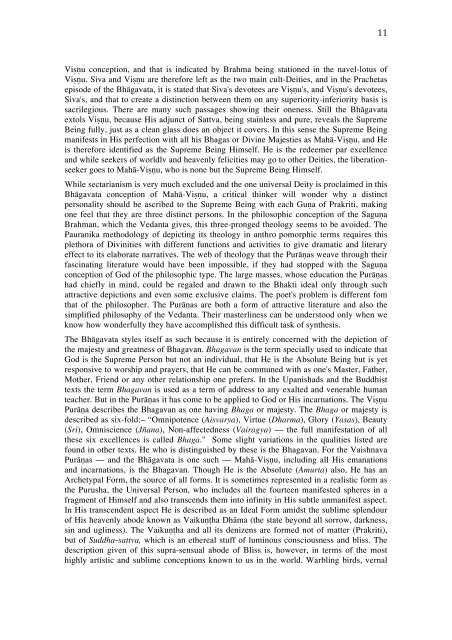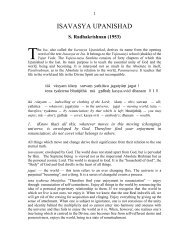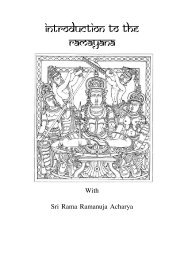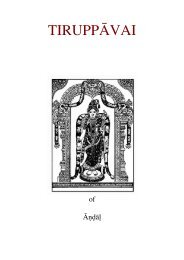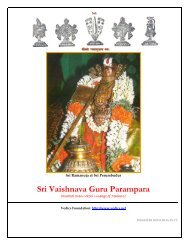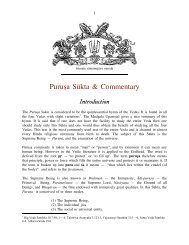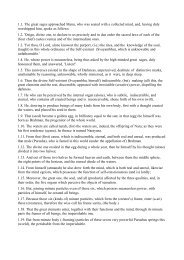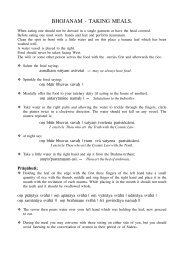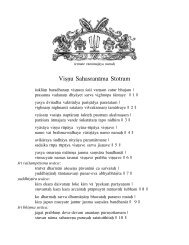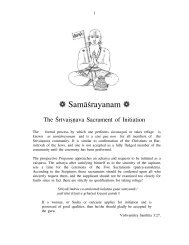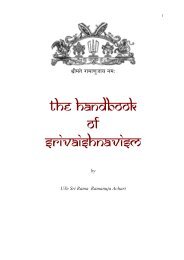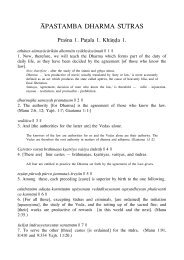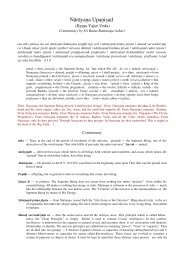Skandha 1 - Yajur Veda Australasia - Resources
Skandha 1 - Yajur Veda Australasia - Resources
Skandha 1 - Yajur Veda Australasia - Resources
Create successful ePaper yourself
Turn your PDF publications into a flip-book with our unique Google optimized e-Paper software.
11 Viṣṇu conception, and that is indicated by Brahma being stationed in the navel-lotus ofViṣṇu. Siva and Viṣṇu are therefore left as the two main cult-Deities, and in the Prachetasepisode of the Bhāgavata, it is stated that Siva's devotees are Viṣṇu's, and Viṣṇu's devotees,Siva's, and that to create a distinction between them on any superiority-inferiority basis issacrilegious. There are many such passages showing their oneness. Still the Bhāgavataextols Viṣṇu, because His adjunct of Sattva, being stainless and pure, reveals the SupremeBeing fully, just as a clean glass does an object it covers. In this sense the Supreme Beingmanifests in His perfection with all his Bhagas or Divine Majesties as Mahā-Viṣṇu, and Heis therefore identified as the Supreme Being Himself. He is the redeemer par excellenceand while seekers of worldlv and heavenly felicities may go to other Deities, the liberationseekergoes to Mahā-Viṣṇu, who is none but the Supreme Being Himself.While sectarianism is very much excluded and the one universal Deity is proclaimed in thisBhāgavata conception of Mahā-Viṣṇu, a critical thinker will wonder why a distinctpersonality should be ascribed to the Supreme Being with each Guṇa of Prakriti, makingone feel that they are three distinct persons. In the philosophic conception of the SaguṇaBrahman, which the <strong>Veda</strong>nta gives, this three-pronged theology seems to be avoided. ThePauranika methodology of depicting its theology in anthro pomorphic terms requires thisplethora of Divinities with different functions and activities to give dramatic and literaryeffect to its elaborate narratives. The web of theology that the Purāṇas weave through theirfascinating literature would have been impossible, if they had stopped with the Saguṇaconception of God of the philosophic type. The large masses, whose education the Purāṇashad chiefly in mind, could be regaled and drawn to the Bhakti ideal only through suchattractive depictions and even some exclusive claims. The poet's problem is different fomthat of the philosopher. The Purāṇas are both a form of attractive literature and also thesimplified philosophy of the <strong>Veda</strong>nta. Their masterliness can be understood only when weknow how wonderfully they have accomplished this difficult task of synthesis.The Bhāgavata styles itself as such because it is entirely concerned with the depiction ofthe majesty and greatness of Bhagavan. Bhagavan is the term specially used to indicate thatGod is the Supreme Person but not an individual, that He is the Absolute Being but is yetresponsive to worship and prayers, that He can be communed with as one's Master, Father,Mother, Friend or any other relationship one prefers. In the Upanishads and the Buddhisttexts the term Bhagavan is used as a term of address to any exalted and venerable humanteacher. But in the Purāṇas it has come to be applied to God or His incarnations. The ViṣṇuPurāṇa describes the Bhagavan as one having Bhaga or majesty. The Bhaga or majesty isdescribed as six-fold:– “Omnipotence (Aisvarya), Virtue (Dharma), Glory (Yasas), Beauty(Sri), Omniscience (Jñana), Non-affectedness (Vairagya) — the full manifestation of allthese six excellences is called Bhaga." Some slight variations in the qualities listed arefound in other texts. He who is distinguished by these is the Bhagavan. For the VaishnavaPurāṇas — and the Bhāgavata is one such — Mahā-Viṣṇu, including all His emanationsand incarnations, is the Bhagavan. Though He is the Absolute (Amurta) also, He has anArchetypal Form, the source of all forms. It is sometimes represented in a realistic form asthe Purusha, the Universal Person, who includes all the fourteen manifested spheres in afragment of Himself and also transcends them into infinity in His subtle unmanifest aspect.In His transcendent aspect He is described as an Ideal Form amidst the sublime splendourof His heavenly abode known as Vaikuṇṭha Dhāma (the state beyond all sorrow, darkness,sin and ugliness). The Vaikuṇṭha and all its denizens are formed not of matter (Prakriti),but of Suddha-sattva, which is an ethereal stuff of luminous consciousness and bliss. Thedescription given of this supra-sensual abode of Bliss is, however, in terms of the mosthighly artistic and sublime conceptions known to us in the world. Warbling birds, vernal


